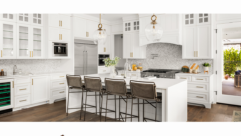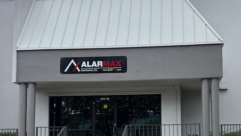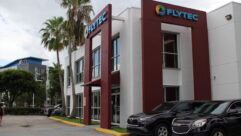Serving success
Oct 1, 2000 12:00 PM,
Rosanne Soifer
Experienced A-V contractors share their insight and tips for the restaurant and bar installation market.
Bar 169 on Manhattan’s Lower East Side has been a neighborhood fixture for at least 50 years. The building is grandfathered, and as such, it cannot be forced to close because of new schools or churches in the surrounding area. Until quite recently, the Bar’s clientele consisted mostly of, as new owner Robert DeBlasio describes them, full-time drunks. The elderly woman who previously owned Bar 169 installed, if that’s the correct term, a security system consisting of two Doberman pinschers and a picture of the Pope behind the bar. The sound system, again stretching the definition somewhat, involved a radio and a jukebox. The DJ booth was actually a small storeroom filled with extra toilet paper and beer bottles, along with the usual turntables and mic. The entire establishment exuded a depressing sense of downward mobility.
No longer. Since January 2000, when actor Robert DeBlasio took over Bar 169, it has been featured in Italian Vogue and Time Out New York, and it is becoming known as a local watering hole with live and recorded music and well-known DJs. Bar 169 reflects the changing character of the neighborhood as well. Former fixed-price co-ops now sell for close to $500,000. Nearby, Orchard Street lofts are attracting the young, hip and hopefully soon-to-be wealthy.
DeBlasio said, “The first thing I knew was that I’d have to upgrade both the sound and the decor if I hoped to attract any decent entertainment. I stripped the walls down to expose the brick and put in a new floor, a ceiling with soundboard and some spray insulation. Only after I did this was I able to know what kind of a bare-bones A-V set-up I’d need for starters. I eventually went with Shure mics, an eight-channel Crate PA system and Technic 1200 turntables. We’re also using JBL speakers for a surround feeling. The CD player is behind the bar, and the new PA system emanates from the DJ booth.”
DeBlasio has this advice for contractors considering a place like Bar 169 as a potential client: “A place under new ownership is generally looking to present a new image. The owner wants to upgrade the A-V, but understand that nine times out of 10, he’s looking to upgrade cosmetically as well. Work with him on that and don’t trot out the Rolls Royce when you’re discussing installations. Also, remember that whenever a place upgrades its entertainment technology, the security system should be upgraded as well. A contractor should be prepared to offer that as part of his package or be able to recommend someone.”
Jack Eisenstein, president of A&B Alarm Co. in NYC said, “Since Bar 169 is so dark, we’re installing a low-light video camera on an angle that will monitor the bar area and cash register. This will be recorded on a time-lapse recorder, much like what is used for security at ATMs. Bar 169 is open basically all night when most burglaries take place, so theft of equipment and fixtures is not a problem, but internal security is.”
The independentsWith venues that are themed, franchised or part of a chain, there may be some uniformity as far as appearance and the type of clientele. Independent venues are all different. Russ Dubrow, president of Electronic Technology in Los Angeles, said, “I’ve found that most independents ask for sound, TV and music – no specifics. They depend on me for the particulars. Sometimes I’ll try to get them a special deal on a new product if they’re willing to be a first-time guinea pig.”
Ted Rothstein, sound designer and president of TR Technologies in NYC, said, “It’s important to understand the business structure of independent venues, say typically an upscale, new one. Many of them are set up with one general partner and a bunch of silent partners or investors. More money needs to be raised all the time, and few projects generally come in on the budget – they generally go over. With a restaurant chain or franchise, their accounting practices are usually more standardized or at least consistent; everything can be more accurate.”
“Understand the money parameters of independent venues, besides what you initially agree on as a budget,” said Barry Scott, CEO of New York Sound & Visual, Scarsdale, NY. “Deal directly with the owner, not anyone else, and don’t extend credit because even if he eventually pays up, it costs time and money to collect.”
Don Jacobs, owner of Midnight Express in Brooklyn, said, “With an independent venue, the last thing I ask about is budget. First, I find out how the system is going to be used. Then, I’ll generally present them with two or three price options from deluxe to cheap and dirty. That way, I’ll get an idea early on as to what they’re willing to spend.”
Stuart Allyn, president of A/W Sound & Vision Ltd., Irvington, NY, said, “With a new venue, hopefully the architect, sound designer, lighting designer and restaurant designer are all brought in at the beginning. Unfortunately, this doesn’t usually happen, and when we come in, it’s usually to correct what has already been done, whether it’s acoustics, sound or buzz from the lights. Generally, bar owners don’t understand A-V, don’t want to understand sound, and don’t want to spend money on it. All they know is when something doesn’t work.”
ChainsEveryone with whom I spoke preferred bar and restaurant chains as clients rather than independent venues. Money was a primary reason, although not the only one. Equally important were the mechanics of the project’s administration.
Rothstein said, “The advantage of working with a chain, besides the greater financial picture, is that once the installation is up and running satisfactorily, the work repeats itself. In other words, there’s a good chance that they’ll call on you for future upgrades. Chains also tend to have budgets that can be cross-collateralized with other budgets, so there’s less chance of them running out of money the way independent venues often do.”
Said Scott, “I’ve found that chains usually specify what they want, and they may use input from their own A-V staff .”
Because a predominant characteristic of a chain is overall uniformity, many, if not all sites, will get upgraded at the same time, not just one. “When that occurs,” said Dubrow, “they’ll naturally look for the cheapest possible way to get things done because of the volume of work. Sometimes they’ll want general background music. For example, Starbucks has its own setup using DMX Music. They pay a monthly fee for a music package – again, ease of operation and uniformity. Other chains have started to burn their own CDs for in-store use.”
Some upscale chains, such as Patina in California, are willing to spend big money – $3.5 million – for a retrofit, including screens and new projectors. Others want to incorporate background music, a PA system, CD player, television, jukebox and video, all controlled from one central point in each location.
Dubrow said, “I’ve had good luck with the Phillips Pronto Remote, a hand-held touchpad that’s remote controlled, usually by the bartender. You can also set up macros that can do multiple functions.”
Themes and variationsSuch themed amusement parks as Disneyland, Sesame Place, and Hershey Park have been part of American family vacations for many years. The restaurants and watering holes within the parks usually reflect the parks’ themes. Such themed restaurants as Hard Rock Cafe, Planet Hollywood, and Harley Davidson Cafe, operating independent of a theme park, however, are a bit newer. Some are independent venues, but most of them are chains.
While most theme parks seem to have been around forever, Opryland being a notable exception (having closed a few years ago, it is now a shopping mall), themed restaurants have a more checkered history. Two highly publicized ventures in New York City, the Fashion Cafe and the Motown Cafe, closed within the past year due, according to most reports, to lousy food and bad management, even though the decor and technology were state-of-the-art.
Rothstein’s client list includes the Hard Rock Cafe and Planet Hollywood (where he’s also done video screens, logos and animated signage), Euro Disney Entertainment Complex and many other themed restaurants. “The decor and ambiance are so important in a themed venue that you generally want speakers and technology invisible,” he said. “Controlling the music environment in a themed club should be failsafe. I’ve developed the TRDJ system, a computer that IDs the venues’ CDs into a database according to musical style. This way, the owner or bar manager can program via a touchscreen appropriate music selections, like a smart jukebox. Because this doesn’t produce a mixed tape as a separate product, it’s legal.”
Said Scott, “In a themed venue, you try not to have the technology visible; most places want to hear it, not see it.”
Another example would be the sophisticated Catal Restaurant, Downtown Disney, which is part of the Patina Group of restaurants. It is scheduled to open by the holiday season. The theme is “the rest of California with a touch of rustic Mediterranean decor, not Mickey and Minnie,” said Dubrow, who is managing the project. “Speakers will be built into decorative Champaign flutes several stories high in the wine bar.” The architect is George Bennett of Backen & Gillam Architects.
Said Allyn, “In Jeckyll & Hyde, the gear is invisible, but the effects are great. However, in another themed venue I worked on called Television City, everything was visible in order to simulate a TV studio environment, but the venture failed because the owners were ignorant of both show business and sound.”
The owners of the latest project of the Walters-Storyk Design Group are adding to a previous success story in the club business. In Basel, Switzerland, WSDG is providing acoustical consultation for the newest Mad Max Club: Mad Max II, due to open October 2000. The theme is based on the Mad Max movies starring Mel Gibson. This large-scale dance club presents complex acoustical challenges which will require recording studio-like room-within-a-room construction to compensate for its sensitive location, a commercial concrete building next to a five-star hotel with extremely high noise restrictions.
Said Dirk Noy, director of WSDG-Europe, “The club’s sound system comprises custom-built cabinets that are based on JBL components. The subwoofers are based on couple-driver push-push technology that will minimize distortion and mechanical vibration, which further helps sound isolation toward the neighboring hotel.”
Honesty countsYou can’t always get what you want if you’re unwilling to spend the money. The professionals I contacted were unanimous on this. A few have had luck educating venue owners by presenting a wide array of options.
Dubrow said, “The last project I worked on was budgeted at around $750,000. The owner wanted incredible music and gave me a free hand; that was pure luck. Otherwise, I’d recommend giving them a class A price and a generic B price. Show them where parts of the budget can be maneuvered.”
Rothstein said, “Your original prospectus should be full-blown, and you can trim from there. Give a wide variety of options.”
Scott said, “You must look at the client’s objective and their needs – background, foreground, satellite, live, recorded or TV. Where might they go in the future? And make sure you can take them into the future – that the system you set up is expandable. Also, if you offer them rentals on an as-needed basis for gear they may be unwilling to buy, they’ll remain an active client.”
Allyn said, “I deal with high-end clients in a series of meetings where we’ll ask for any drawings or photos they might have, and then we’ll put together a scope-of-services outline with fees.” He agreed with Scott in that you should “try to get the client to anticipate what they may want in the future – for example, pre-wiring for video conferencing to a sister restaurant, live music or karaoke.”
Operations and servicingHigh employee turnover is common in bars and restaurants, even upscale ones. When recommending gear that will be operated by large numbers of people in less than optimum conditions – dirt, smoke and dampness – keep it simple. Dubrow said, “Get as many things out of the system as you can. Print an easy-to-read script and slap it all over the equipment. You can be creative with service contracts if you’re a small company by combining them with barter, or if we’re adding new gear with the client’s old stuff, I’ll warranty ours but not theirs. Sometimes, we’ll get a service contract on their gear.”
Scott said, “Make it simple, automatic if possible. The Bogen Matrix System, for example, is integrated and can automatically switch input for three different levels, three different areas. Offering service contracts, I find, can be good and bad. Good because it provides some steady monthly income. Bad because if I can’t get to the venue personally to take care of a problem, they feel cheated.”
Jacobs combines gear operation and service contracts by asking the venue “to define long-term staff who will be on the premises to deal with such small maintenance procedures as cleaning, dusting, low-level maintenance and protecting the equipment site. I’ll offer them training as part of the bid I submit. You must also be very careful how you define service.”
Allyn offers service contracts to some clients, but tends to stay away from them with bars and restaurants because, as he puts it, “the stuff gets very abused even under the best of conditions. I’d rather deal with any problems on a house-call basis.”
Similarly, Rothstein said, “I prefer a house-call basis. I tend to use standardized components and brands. Any replacement parts can be handled by restaurant personnel.”
Pre-existing conditionsMany new restaurants and bars have been built into spaces that previously existed as something else; abandoned lofts, warehouses and banks have been quickly converted as surrounding areas are revitalized. Along with all the spaciousness, however, may come landmark-status architecture that cannot be easily altered, impossibly high ceilings and inadequate wiring and electrical support. There may also be a pre-existing A-V system of some kind that the venue cannot, or may be unwilling to, eliminate.
Rothstein said, “Find out beforehand exactly how much reconfiguring you’ll be able to do without a hassle – the architect should research the status of the building. You have to inform the client that the pre-existing A-V system might sound all right in a high school auditorium but not for what he’s planning. Discuss the needs to change the basic system.”
Scott said, “In New York City, I have to know the building’s status. For example, where I can and can’t hang stuff and if wiring has to be in a tube or not.”
Jacobs said, “In New York City especially, a lot of restaurants were previously something else, and landmark status usually refers to the building’s exterior, not the interior, although sometimes, it’s both. I find the big issue here is how to mount speakers; I try to avoid ceiling mounts.”
Allyn said, “I’ll sometimes generate blueprints if none exist in order to work more effectively around pre-existing conditions. Try to re-use something of value, even if you have to move it to another room in a multi-room venue, or see if the client would sell it and put that money towards better gear.”
Dubrow, preferring to combine several approaches to pre-existing conditions, said, “We’ll bench-test the client’s gear for quality and make an assessment. If the venue is landmarked, try to make everything as portable as possible so that both structural integrity and design can be maintained. The electrical wiring is crucial; if you build a column, for example, it has to be architecturally compatible with the rest of the venue.”
Outdoor gear, obviously, has to be both heat and water resistant; loudspeakers disguised as rocks within the landscape are popular, especially in Las Vegas. Jacobs said, “Your primary concern should be the wear and safety of the wiring, and you may have to submit drawings in order to get a permit for outdoor work.”
Working in the restaurant and bar installation market may seem a daunting task. With these tips and guidelines at your disposal, however, the path for success should be clear.










